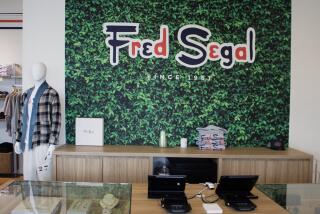Column: Lands’ End, after years of struggle, searches for its retail mojo
Lands’ End once again is seeking a path out of the retail wilderness, and I’m hoping it makes it.
It’s not that the company, which last week hired a new chief executive, is particularly essential to the retail landscape. But it would be nice to think that well-established businesses that have had a few hard knocks can nevertheless find their place in a world where any dot-com is a player.
The fact that I work for a newspaper probably has a lot to do with my rooting for the underdog here.
“There’s no easy fix for Lands’ End,” said Steve Goldberg, president of the Grayson Co., a New York retail consulting firm. “They’re all about lifestyle, but they lost sight of who they are as a brand.”
Lands’ End’s woes are reflective of many retailers straddling two worlds. On the one hand, it still relies heavily on old-school methods such as catalog and brick-and-mortar sales. On the other, if it can’t master the online marketplace, it’s toast.
Not right away, of course. An estimated 85% of retail sales still take place off-line. But e-commerce is quickly catching up.
This year, Cyber Monday, the online follow-up to Black Friday, produced a record $3.45 billion in sales, up about 12% from last year. Moreover, a record $3.34 billion in online sales was logged on Black Friday.
Total online sales this holiday season are expected to top $40 billion.
Lands’ End’s new boss is Jerome Griffith, the former skipper of high-end luggage merchant Tumi Holdings. He’s replacing Federica Marchionni, who stepped down in September after less than two years on the job.
Marchionni thought she could reinvent Lands’ End as an upscale brand. She was way wrong.
“As Lands’ End continues its evolution at the forefront of the retail industry, we believe Jerome’s experience and tactical execution will improve financial performance and build sustainable long-term value for stockholders,” the company’s chairwoman, Josephine Linden, said in a statement.
That remains to be seen. Over the first nine months of the current fiscal year, Lands’ End’s sales fell 7.3% to $877 million and the company posted a loss of almost $15 million. Its year-over-year sales have fallen for nine straight quarters.
I’m pulling for Lands’ End in part because of nostalgia. I discovered the company’s catalogs during the seven years I lived in Tokyo, where I couldn’t find clothes that fit me at anything close to an affordable price.
Suddenly I had access to decent shirts, pants, shoes and accessories that didn’t cost an arm and a leg (even with international shipping).
This was in the early days of the Internet, before the Web became the world’s biggest shopping mall, when Amazon was still just a newfangled way of mail-ordering books.
And Lands’ End was still kind of cool. It’s been selling stuff by catalogs for more than half a century, which may not make it L.L. Bean — which has been at it about twice as long — but that’s still plenty of direct-marketing retail mileage.
What did Lands’ End offer at the time? You could say its clothes were dull. I’d say they were good, solid, nothing-fancy American duds (albeit often manufactured elsewhere). They were L.L. Bean but less outdoorsy, J. Crew but less flashy.
Lands’ End was where you’d shop if you knew what you liked and weren’t obsessed with being cutting-edge fashionable season to season. And don’t get me started on the whole skinny-pants thing for guys.
Where the company went wrong, Goldberg said, was in agreeing to be acquired by Sears in 2002 for about $2 billion and to start selling its clothes in Sears stores.
“It may have generated sales, but it did nothing for the brand,” he said.
Sears threw in the towel a dozen years later, spinning off Lands’ End in 2014 as a separate company. But the damage was done.
Weirdly, Lands’ End turned to Marchionni, a former Dolce & Gabbana exec, as its savior. That left many observers — and, more importantly, consumers — scratching their heads.
“You can’t mess with a brand’s DNA,” Goldberg said. “That’s a recipe for disaster.”
I asked Lands’ End if I could speak with Griffith about his plans for the company’s future. No one got back to me.
But experts I spoke with agreed on this much: Lands’ End serves as a cautionary tale for survival in a fast-changing industry.
“Retail is a business that’s constantly in transformation,” said Gene Bornac, vice president of the consulting firm Boston Retail Partners. “Right now, we’re in one of the biggest periods of transformation ever.”
The buzz word I heard most from industry insiders was “relevance.” If a business or brand isn’t deemed “relevant” by customers — that is, hip, trendy and offering high quality at low prices — it can quickly become roadkill.
Other survival tips:
- Don’t skimp on the technology. Internet users want to interact with sites that are intuitive and easy to navigate, making purchases as easy as possible. Think Amazon.
- Be true to your roots. A brand can’t be all things to all people. Know who your customers are and what they want.
- Make sure your website and your stores work together — the so-called omnichannel experience. Customers like buying online after browsing in a store. They also appreciate being able to return an item to a store that they purchased online.
- Be nimble enough to change and adapt quickly. Today’s consumers are more fickle than ever. Retailers no longer can afford to be set in their ways.
Ultimately, retail is about cool, about having the stuff or style that others want.
Lands’ End isn’t cool. I haven’t bought anything from the company in years, and being no slave to fashion — ask my newsroom colleagues — I’m about as target-market as they come.
Job one for Griffith: Ditch the upscale sensibility. Forget about being something you’re not.
Start with a really great pair of khakis. Add some well-made dress and casual shirts. Build from there.
I may not know relevance. But I know what fits.
David Lazarus’ column runs Tuesdays and Fridays. He also can be seen daily on KTLA-TV Channel 5 and followed on Twitter @Davidlaz. Send your tips or feedback to [email protected].
More to Read
Inside the business of entertainment
The Wide Shot brings you news, analysis and insights on everything from streaming wars to production — and what it all means for the future.
You may occasionally receive promotional content from the Los Angeles Times.











